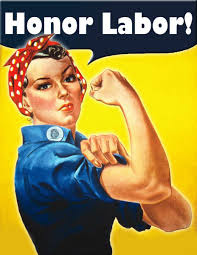Labor Day...
The first Monday in September is celebrated nationally as Labor Day, which is the creation of the labor movement and is dedicated to the social and economic achievements of American workers. It constitutes a yearly national tribute to the contributions workers have made to the strength, prosperity, and well-being of our country.
Labor Day holiday grew out of the late 19th century organized labor movement, and it quickly became a national holiday as the labor movement assumed a prominent role in American society. Here is how it all started, with facts supplied by the Labor Department, the Library of Congress and other sources.
Through the years the nation gave increasing emphasis to Labor Day. The first governmental recognition came through municipal ordinances passed during 1885 and 1886. From these, a movement developed to secure state legislation. The first state bill was introduced into the New York legislature, but the first to become law was passed by Oregon on February 21, 1887. During the year four more states - Colorado, Massachusetts, New Jersey, and New York - created the Labor Day holiday by legislative enactment.
By the end of the decade, Connecticut, Nebraska, and Pennsylvania had followed suit. By 1894, 23 other states had adopted the holiday in honor of workers, and on June 28 of that year, Congress passed an act making the first Monday in September of each year a legal holiday in the District of Columbia and the territories.
The form that the observance and celebration of Labor Day should take was outlined in the first proposal of the holiday - a street parade to exhibit to the public "the strength and esprit de corps of thee trade and labor organizations" of the community, followed by a festival for the recreation and amusement of the workers and their families. this became the pattern for the celebrations of Labor Day. Speeches by prominent men and women were introduced later, as more emphasis was placed upon the economic and civic significance of the holiday. Still later, by a resolution of the American Federation of Labor convention of 1909, the Sunday preceding Labor Day was adopted as Labor Sunday and dedicated to the spiritual and educational aspects of the labor movement.
The character of the Labor Day celebration has undergone a change in recent years. especially in large industrial centers where mass displays and huge parades have proved a problem. this change, however, is more a shift in emphasis and medium of expression. Labor Day addresses by leading union officials, industrialists, educators, clerics and government officials are given wide coverage in newspapers, radio, and television.
The vital force of labor added materially to the highest standard of living and the greatest production the world has ever know and has brought us closer to the realization of our traditional ideas of economic and political democracy. It is appropriate, therefore, that the national pay tribute on Labor Day to the creator of so much of the nation's strength, freedom, and leadership - the American worker.
This research in where Labor Day started from, is from unions. Today there are still unions, but the biggest union today is the National Education Association, which has 3 million members. These members are both active and inactive, which includes our teachers from preschool to university and college professors. According to the Bureau of Labor Statistics, there were 14.6 million union members in the work force in 2014. There were 17.7 million in 1983. As you can see, there are less union members today. People are finding and hold non-union jobs.
Tell me, how did you spend your Labor Day? If you hold a union job, what do you do?



Comments
Post a Comment